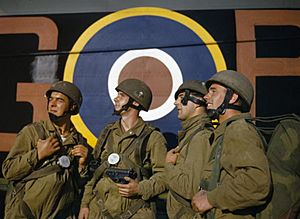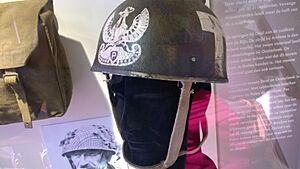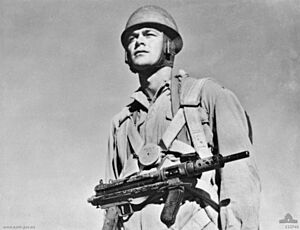Helmet Steel Airborne Troop facts for kids
The Helmet Steel Airborne Troops (HSAT) was a special helmet worn by paratroopers and soldiers who landed from planes. It was first used by the British Army during World War II and also by armies from other countries that were part of the Commonwealth.
This helmet was used for a long time, from the 1940s until the early 1980s. It was being replaced by a newer helmet when the Falklands War happened. The HSAT helmet was made by Briggs Motor Bodies, the same company that made similar helmets for tanks and motorcycle riders.
Contents
Different Types of HSAT Helmets
During World War II, there were four main types of the HSAT helmet. The last version was updated again in the mid-1950s.
P Type Helmet
The very first version was a prototype, meaning it was a test model. It was used during a special mission called the Bruneval Raid. These early helmets had rubber padding at the back. They were not used for long before being replaced by the main HSAT design.
The first steel helmets were made in 1941. Only about 500 to 1,000 of these "P Type" helmets were made. They had a special steel shell that wasn't magnetic, a rubber rim, and padding inside that was similar to German helmets of that time.
Some soldiers kept using these P Type helmets throughout the war. You can even see one that was worn during the Battle of Arnhem at the Hartenstein Museum in the Netherlands.
HSAT (Early Version)
The next version of the British helmet came out in 1942. It looked similar to the P Type but had a thick, strong fiber rim. This rim helped tell it apart from German helmets. It also had a four-point chin strap system and soft rubber padding inside. The very first of these helmets had leather chin straps and are quite rare today.
HSAT Mk I
This was the third main version of the helmet, released in October 1942. It still had the leather chin straps but used a steel rim instead of the fiber rim.
HSAT Mk II
The fourth and final main version came with a new three-point chin strap made of webbing material. This Mk II helmet was used even after World War II, staying in service until around the time of the Falklands War. In the 1980s, some older chin straps were even reused on newer, lighter helmets made of glass-reinforced plastic.
The parts of the wartime helmets were a bit different from those made after the war in the 1950s. Wartime chin straps had brass ends and rivets, while the 1950s versions used blackened steel. The loops on the side of the helmet for the chin strap were also slightly different in the postwar helmets.
Who Used Them?
Many countries used the HSAT helmet, especially those with paratrooper forces or close ties to the British military.




